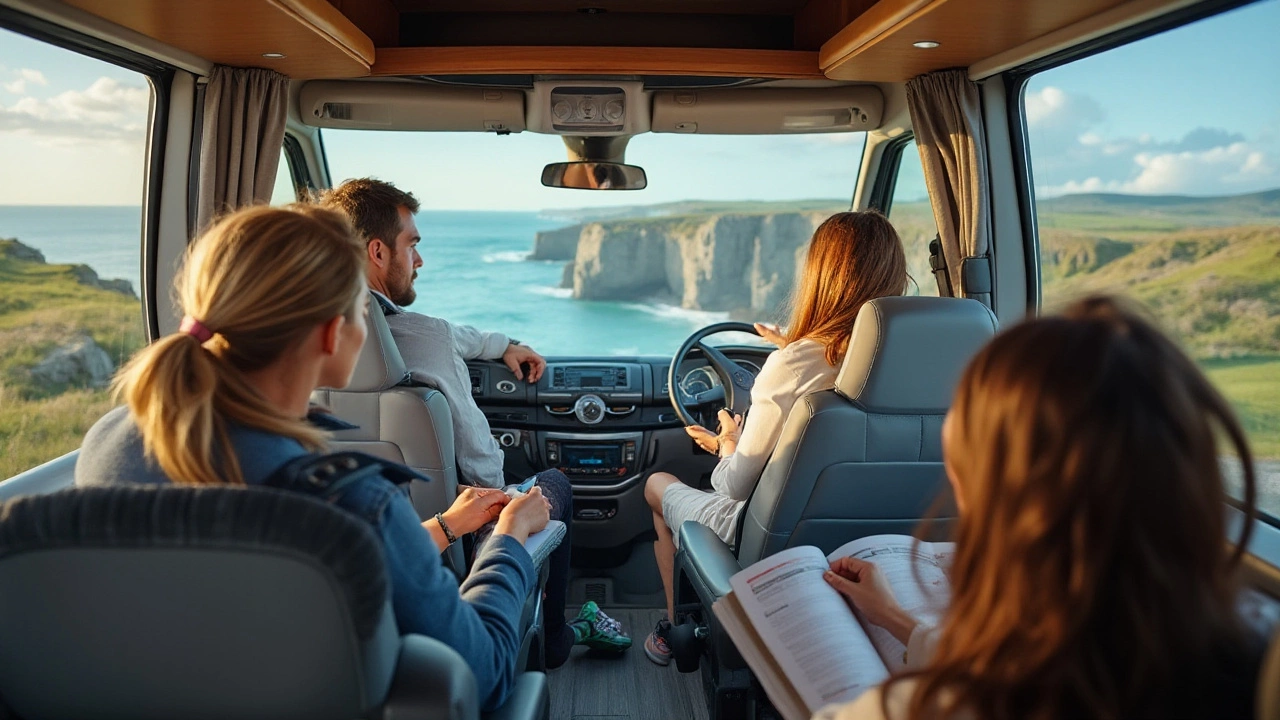Walking Inside Your Motorhome: What You Need to Know About Laws and Safety
 Oct, 17 2024
Oct, 17 2024
Motorhome travel has become a beloved pastime for many adventurers, offering the freedom to explore the open road with the comforts of home. Yet, amidst the comforts, questions often arise about what is permissible while the vehicle is in motion—particularly, whether one can walk around inside the motorhome during travel.
Different regions have varied regulations, and understanding these laws can be as important as knowing the speed limits. While many RV enthusiasts assume it's safe to roam from the kitchen to the living area while cruising along the highway, legal and safety considerations suggest otherwise. Seatbelt laws play a significant role, and it's essential to keep safety top of mind.
While we navigate these questions, it’s equally important to consider the real-world safety implications. A sudden stop or a tight turn could make that stroll across the moving vehicle riskier than it seems. This article delves into what you should know to ensure you're both within the law and safe during your travels.
- Legal Requirements Overview
- Safety Concerns
- Regional Variations
- Tips for Travelers
- Common Misconceptions
- Staying Safe on the Road
Legal Requirements Overview
When it comes to walking around inside a motorhome during travel, the legal requirements can be a bit of a maze, depending largely on where you are. Different states and countries have their own rules that may or may not align with what feels practical or safe for travelers. In the United States, for example, the law prioritizes seatbelt use. This means that, by law, passengers should ideally remain seated and strapped in while the vehicle is in motion. Yet, the enforcement of such laws can vary, with some areas having stricter guidelines than others. It's always crucial to check local laws before setting off on your next adventure.
In Europe, the regulations are similarly varied but frequently more stringent. Many nations require that all passengers be seated with their seatbelts fastened while the motorhome is on the move. This is particularly emphasized in countries like Germany and France where transportation safety laws are rigorously enforced. The European Union has standardized vehicle safety laws to a degree; however, travelers might still encounter a patchwork of regulations, especially in non-EU countries or in remote areas. Clearly, the desire to move freely in your mobile haven needs to be balanced with abiding by these preset rules.
An interesting perspective was shared by the American Automobile Association (AAA), which noted, "Staying seated and belted while traveling in an RV is one of the simplest yet most effective safety measures available." This highlights the ongoing tension between the freedoms typically associated with road tripping and the critical need for safety and compliance with the law. While the temptation to get up and grab a snack during a long journey is understandable, knowing when and where it is safe—and legal—to do so is essential.
For those traveling through various jurisdictions, it helps to become acquainted with a few international safety standards and common practices. For instance, motorhomes typically come equipped with special seating arrangements to comply with regulations in multiple regions. These may include forward-facing seats equipped with three-point seatbelts approved for use in transportation. Understanding these modifications and utilizing them correctly can spare travelers a great deal of trouble as they cross borders and state lines.
Legal nuances become even more complex when it comes to insurance implications. Accidents that occur when passengers aren't adequately restrained could potentially lead to complications with insurance claims. Policies often include clauses that outline coverage limitations related to non-compliance with seatbelt laws. Therefore, understanding these stipulations before you embark is not just wise, it’s necessary. Motorhome enthusiasts are encouraged to consult with their insurance providers to understand how regional laws affect their coverage.
The legal landscape around motorhome travel continues to evolve, often in response to technological and structural changes in vehicle design. Some regions are considering relaxing rules regarding passenger movement within RVs as models with enhanced safety features become more commonplace. While strict adherence to local regulations is non-negotiable, staying informed about current and emerging guidelines can greatly enhance both the enjoyment and safety of your trip.
Safety Concerns
When it comes to motorhome travel, the allure of comfort and convenience while on wheels is unmistakable. However, the question of safety arises when contemplating moving around inside the motorhome during transit. Safety should always be a primary concern for all road travelers. The fundamental rule that many often overlook is wearing seat belts. While it's tempting to walk from the couch to the fridge, unpredictable road conditions can present unanticipated dangers. A sudden swerve or an unplanned brake could turn a simple cabin stroll into a hazardous venture. It's important that travelers keep this in mind to ensure their well-being is prioritized.
The interior of a motorhome isn't designed to endure the forces of sudden stops or accidents without the precautions of being seated and belted. The allure of sitting at a table or lying on a bed while traveling may be appealing, but the seats and seatbelts are there for a significant purpose. Statistics from road safety organizations have shown that the likelihood of injury in motorhomes increases exponentially with unrestrained movement inside the vehicle. According to the National Highway Traffic Safety Administration, wearing seat belts in motor vehicles reduces the risk of death by 45% and injury by 50%. These statistics are a stark reminder of the importance of safety measures.
Adequate grip and support within the interior are essential to consider, even for motorhomes moving at slower speeds. The vehicle's motion can create an unstable environment where a sudden toppling of dishes or loose objects can become precarious. It's advisable that travelers ensure all items are securely stored before hitting the road. Additionally, the vehicle's weight and high center of gravity should be considered, as any movement inside during abrupt turns could affect stability significantly.
"For every journey taken in a motorhome, understanding the inherent risks and preparing accordingly is vital," says road safety expert, Dr. Richard Moles. "The key is combining enjoyment with responsibility."
In sum, always remember the unpredictability of the road. Adverse weather, traffic, or unexpected obstructions can demand immediate reactions from the driver, leaving little time for those moving inside to secure themselves. A proactive approach in anticipating potential hazards can alleviate many safety concerns, ensuring that your journey remains memorable for the right reasons. Whether you're new to RV life or a seasoned motorhome traveler, safety concerns must always be at the forefront of every adventurous road trip.

Regional Variations
When it comes to moving around inside a motorhome while on the road, the rules can vary significantly depending on where you are traveling. Different regions and countries have their own sets of regulations that must be adhered to. In some places, staying seated with your seatbelt fastened is strictly enforced, while others might be more lenient. These differences can often reflect the local driving conditions, road types, and cultural attitudes towards road safety. Understanding these variations is essential for anyone planning to embark on a motorhome adventure across different states or countries. It adds a layer of preparation that ensures not only compliance but also safety for everyone inside the motorhome.
In the United States, for example, the rules can vary from state to state. Many states require all passengers to wear seatbelts while the vehicle is moving, including those in motorhomes. However, there might be exceptions for occupants using facilities within the vehicle, such as the restroom, provided the vehicle is not on a major highway. California is known for its stringent safety laws, while states like Texas may have more relaxed regulations. In Europe, the situation can differ even more drastically. The European Union has standardized some safety regulations, yet each member country might have additional rules. Germany, with its famous Autobahns, insists on strict adherence to safety protocols, while countries like Italy might approach enforcement differently. These jurisdictional differences emphasize the need for travelers to research specific laws before hitting the road.
Some travelers have shared experiences regarding regional travel peculiarities. A prevalent sentiment among the RV community is to always 'expect the unexpected.' For instance, in Australia, the long stretches of open roads in the outback have led to more relaxed views about moving within the motorhome. Nevertheless, safety remains paramount, and seasoned travelers often advise securing all heavy items inside the vehicle before setting off.
“There are places where the spirit of adventure meets the reality of rules. That’s where common sense becomes your best travel companion,” says renowned travel writer and RV enthusiast, Mark Pearson.This need to balance safety with the practicalities of road travel serves as a reminder that laws not only protect but also enhance the traveling experience by setting a standard for safety that benefits everyone on the road.
Diving deeper, it's interesting to note how some regions adjust road rules based on local conditions. In places with narrow roads and challenging driving terrain, like the mountainous areas of Switzerland, regulations may be stricter to minimize distractions for the driver. Conversely, driving on the expansive, flat roads in parts of the United States or Canada might present less immediate danger, influencing a certain flexibility in enforcement. Whether one is a local or a visitor, understanding these regional variations is crucial to making informed decisions about safety and legality when walking inside a moving motorhome. This insight into why rules differ aids travelers in adequately preparing for the unique challenges of each region, ensuring they enjoy the journey as much as the destinations.
Tips for Travelers
Embarking on a road journey in a motorhome is a thrilling way to see the world, but staying safe and legal requires some know-how. First and foremost, it is crucial to equip yourself with knowledge about the legality of walking in your motorhome while it's in motion. Many regions mandate that passengers remain seated with their seatbelts fastened. Remember, the rules aren't just there to spoil the fun; they're about ensuring the safety of everyone onboard. Many accidents are caused by abrupt stops or quick turns where unsecured passengers can be tossed or injured.
Motorhome safety doesn't end with seatbelt compliance. Secure all loose items before hitting the road to prevent them from becoming hazardous projectiles. A well-organized motorhome ensures that appliances and luggage are stored or clamped down. Consult your motorhome manufacturer’s manual for guidance on secure storage options provided within your vehicle. It's wise to check your smoke and gas detectors regularly. These small devices are vital in detecting potentially dangerous situations.
Consider planning stops at rest areas or campsites where everyone in the vehicle can stretch their legs and enjoy the surrounding scenery safely. Strategically plan these stops along your route and follow a schedule as closely as possible to avoid fatigue. A well-rested driver is a safe driver, after all.
According to a study by the Insurance Institute for Highway Safety, being ejected from the vehicle increases crash fatality rates by 2.5 times.
Being familiar with local road laws and cultural driving norms is another layer of safety. By doing so, motorhome travelers can avoid unexpected surprises or fines, ensuring a smoother ride. Make it a habit to quickly glance at regional traffic websites or mobile apps offering real-time insights and suggestions.
Finally, don’t shy away from connecting with fellow RV travelers at campsites or online forums. Sharing experiences and tips within these communities can enrich your travel planning. Veteran travelers often provide practical insights that aren't mentioned in manuals, from the best pit stops to the hidden gem destinations along your path.

Common Misconceptions
Motorhome travel brings along a unique set of myths and misunderstandings. One common misconception is the belief that all states or regions automatically allow for free movement within a motorhome while it's on the road. This notion comes from the romanticized portrayal of motorhome travel in media, where people roam the length of the vehicle without any regard for safety protocols or legality. In reality, most areas have stringent seatbelt laws that apply to all moving vehicles, including motorhomes. These laws are enforced primarily to ensure safety, as movement during travel significantly increases risk. Even a small, sudden stop could cause serious injury to someone standing or walking around.
Another prevalent myth is the idea that motorhomes, due to their size, are immune to traffic laws that apply to other vehicles. This includes everything from parking restrictions to speed limits. In fact, motorhomes are often subject to even stricter regulations, especially when it comes to road lanes and parking spaces. Overconfidence in the vehicle's largeness often leads to drivers ignoring these important legal boundaries. This could not only result in hefty fines but also increase the risk of accidents. The hefty weight of motorhomes amplifies stopping distances, making adherence to traffic rules particularly crucial.
Additionally, there's the myth that safety features like built-in seatbelts are more of a suggestion than a requirement. Many new motorhomes come equipped with excellent safety features designed to keep all passengers secure during travel, yet some travelers might ignore these or consider them redundant. As an article from "Road Safety Monthly" stated,
"Ignoring seatbelt laws inside a motorhome is akin to taking a seatbelt off in any other car, only with higher stakes due to the increased size and complexity of the vehicle."Following these safety protocols is non-negotiable, both legally and practically, for a safe journey.
The misconception that all motorhome holidays are a carefree escape from rules couldn't be further from the truth. Adhering to laws is a non-negotiable aspect of ensuring a fun and safe journey. With big dreams of traveling in a motorhome, it’s easy to overlook practical needs, such as planning stops and knowing local laws. Enthusiasts must research and prepare ahead of time to navigate not just the highways but also the specific requirements and expectations of places they visit. Fortunately, numerous online forums and guidebooks offer plenty of resources to help travelers gear up for a legally smooth adventure.
Staying Safe on the Road
When embarking on a motorhome journey, ensuring safety on the road should be a priority. The excitement of travel can sometimes make us overlook the essential safety measures needed for a smooth trip. Always start by making sure that the motorhome is in top condition. Check your brakes, tires, and fluid levels before hitting the road. It's also crucial to secure all items inside the motorhome to prevent them from shifting or falling during transit. This is particularly important because unsecured objects can become hazardous projectiles in the event of sudden stops or turns.
One common misconception is that it's permissible to move around inside the motorhome at any time during travel. This could not be further from the truth. The reality is that many regions have laws requiring passengers to be seated and belted in when the vehicle is moving. Adhering to seatbelt laws is not just about staying on the right side of the law; it is a critical component of road safety. Consult the specific regulations of the areas you plan to travel through; they can vary significantly from one jurisdiction to another.
Another vital aspect of staying safe is maintaining an appropriate speed. Motorhomes are not only larger but also heavier than standard vehicles, which means driving them requires extra precaution. Always account for additional stopping distances and be cautious in adverse weather conditions. Tail winds, for example, can exert significant pressure and affect vehicle stability. Motorhome safety isn't just about the driving itself but also involves being prepared for emergencies. Pack a comprehensive first aid kit, and carry a vehicle emergency kit that includes items such as warning triangles, flares, and spare batteries.
For those new to motorhome travel, it might be really helpful to hone driving skills before embarking on extended trips. Consider taking a motorhome driving course or, at least, practice in less populated areas to get used to the vehicle's dimensions and handling. Another practical tip is organizing a travel itinerary so that you have a clear idea of your stops and possible refueling needs. Adopting good practices like taking breaks every couple of hours can greatly enhance your focus, which is vital for safe driving.
Some experienced road trippers also emphasize communication among those in the vehicle. Establishing hand signals or simple codes can be useful for quick communication without becoming a distraction.
"The road is long, and it's shared, so creating signals helps keep everyone in sync," suggests Chris Tremblay, an RV travel enthusiast of over 20 years.Effective team communication also involves sharing navigation duties and ensuring everyone is comfortable with the planned travel.
Motorhome journeys are opportunities for freedom and adventure. However, by putting safety first, preparing thoroughly, and remaining vigilant on the road, these experiences can remain positive and memorable. Remember, the journey is as important as the destination, and traveling wisely is key to enjoying every moment of it.